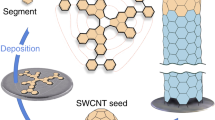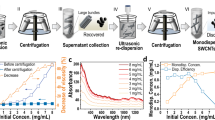Abstract
Chirally pure single-walled carbon nanotubes (SWCNTs) are required for various applications ranging from nanoelectronics to nanomedicine1. Although significant efforts have been directed towards separation of SWCNT mixtures, including density-gradient ultracentrifugation 2, chromatography3 and electrophoresis4, the initial chirality distribution is determined during growth and must be controlled for non-destructive, scalable and economical production. Here, we show that the chirality distribution of as-grown SWCNTs can be altered by varying the composition of NixFe1−x nanocatalysts. Precise tuning of the nanocatalyst composition at constant size is achieved by a new gas-phase synthesis route based on an atmospheric-pressure microplasma. The link between the composition-dependent crystal structure of the nanocatalysts and the resulting nanotube chirality supports epitaxial models and is a step towards chiral-selective growth of SWCNTs.
This is a preview of subscription content, access via your institution
Access options
Subscribe to this journal
Receive 12 print issues and online access
$259.00 per year
only $21.58 per issue
Buy this article
- Purchase on Springer Link
- Instant access to full article PDF
Prices may be subject to local taxes which are calculated during checkout




Similar content being viewed by others
References
Baughman, R. H., Zakhidov, A. A. & de Heer, W. A. Carbon nanotubes—the route toward applications. Science 297, 787–792 (2002).
Arnold, M. S. et al. Sorting carbon nanotubes by electronic structure using density differentiation. Nature Nanotech. 1, 60–65 (2006).
Zheng, M. et al. DNA-assisted dispersion and separation of carbon nanotubes. Nature Mater. 2, 338–342 (2003).
Krupke, R., Hennrich, F., von Lohneysen, H. & Kappes, M. M. Separation of metallic from semiconducting single-walled carbon nanotubes. Science 301, 344–347 (2003).
Bachilo, S. M. et al. Structure-assigned optical spectra of single-walled carbon nanotubes. Science 298, 2361–2366 (2002).
Hata, K. et al. Water-assisted highly efficient synthesis of impurity-free single-waited carbon nanotubes. Science 306, 1362–1364 (2004).
Takagi, D. et al. Single-walled carbon nanotube growth from highly activated metal nanoparticles. Nano Lett. 6, 2642–2645 (2006).
Li, Y. M. et al. Preferential growth of semiconducting single-walled carbon nanotubes by a plasma enhanced CVD method. Nano Lett. 4, 317–321 (2004).
Qu, L. et al. Preferential syntheses of semiconducting vertically aligned single-walled carbon nanotubes for direct use in FETs. Nano Lett. 8, 2682–2687 (2008).
Wang, B. et al. Pressure-induced single-walled carbon nanotube (n, m) selectivity on Co–Mo catalysts. J. Phys. Chem. C 111, 14612–14616 (2007).
Wang, B. et al. (n, m) selectivity of single-walled carbon nanotubes by different carbon precursors on Co–Mo catalysts. J. Am. Chem. Soc. 129, 9014–9019 (2007).
Li, N. et al. Diameter tuning of single-walled carbon nanotubes with reaction temperature using a Co monometallic catalyst. J. Phys. Chem. C 113, 10070–10078 (2009).
Bachilo, S. M. et al. Narrow (n, m)-distribution of single-walled carbon nanotubes grown using a solid supported catalyst. J. Am. Chem. Soc. 125, 11186–11187 (2003).
Li, X. L. et al. Selective synthesis combined with chemical separation of single-walled carbon nanotubes for chirality selection. J. Am. Chem. Soc. 129, 15770–15771 (2007).
Miyauchi, Y. H. et al. Fluorescence spectroscopy of single-walled carbon nanotubes synthesized from alcohol. Chem. Phys. Lett. 387, 198–203 (2004).
Zhang, M., Yudasaka, M. & Iijima, S. Production of large-diameter single-wall carbon nanotubes by adding Fe to a NiCo catalyst in laser ablation. J. Phys. Chem. B 108, 12757–12762 (2004).
Herrera, J. E. et al. Relationship between the structure/composition of Co–Mo catalysts and their ability to produce single-walled carbon nanotubes by CO disproportionation. J. Catalysis 204, 129–145 (2001).
Chiang, W. H. & Sankaran, R. M. Microplasma synthesis of metal nanoparticles for gas-phase studies of catalyzed carbon nanotube growth. Appl. Phys. Lett. 91, 121503 (2007).
Chiang, W. H. & Sankaran, R. M. In flight dimensional tuning of metal nanoparticles by microplasma synthesis for selective production of diameter-controlled carbon nanotubes. J. Phys. Chem. C 112, 17920–17925 (2008).
Chiang, W.-H. & Sankaran, R. M. Synergistic effects in bimetallic nanoparticles for low temperature carbon nanotube growth. Adv. Mater. 20, 4857–4861 (2008).
McKeehan, L. W. The crystal structure of iron–nickel alloys. Phys. Rev. 21, 402–407 (1923).
Kataura, H. et al. Optical properties of single-wall carbon nanotubes. Synth. Met. 103, 2555–2558 (1999).
Samsonidze, G. G. et al. Quantitative evaluation of the octadecylamine-assisted bulk separation of semiconducting and metallic single-wall carbon nanotubes by resonance Raman spectroscopy. Appl. Phys. Lett. 85, 1006–1008 (2004).
Kanzow, H. et al. Single-wall carbon nanotube diameter distributions calculated from experimental parameters. Phys. Rev. B. 63, 125402 (2001).
Ding, F. et al. The importance of strong-carbon–metal adhesion for catalytic nucleation of single-walled carbon nanotubes. Nano Lett. 8, 463–468 (2008).
Gomez-Gualdron, D. A. & Balbuena, P. B. Effect of metal cluster-cap interactions on the catalyzed growth of single-wall carbon nanotubes. J. Phys. Chem. C 113, 698–709 (2009).
Reich, S., Li, L. & Robertson, J. Control the chirality of carbon nanotubes by epitaxial growth. Chem. Phys. Lett. 421, 469–472 (2006).
Yudasaka, M. et al. Causes of different catalytic activities of metals in formation of single-walled carbon nanotubes. Appl. Phys. A 74, 377–385 (2002).
Hersam, M. C. Progress towards monodisperse single-walled carbon nanotubes. Nature Nanotech. 3, 387–394 (2008).
Strano, M. S. et al. Electronic structure control of single-walled carbon nanotube functionalization. Science 301, 1519–1522 (2003).
Acknowledgements
The authors acknowledge the technical assistance of A. Avishai (TEM), A. K. McIlwain (XRD), K. Singer (ultraviolet–visible–NIR), R. Silvestri and J. Koenig (micro-Raman spectroscopy), M. Barkley and E. Arts (ultracentrifuging) and F. Du and L. Dai at University of Dayton (multiline micro-Raman spectroscopy). The authors are also grateful to C. C. Liu and J. Angus for discussions.
Author information
Authors and Affiliations
Corresponding author
Supplementary information
Supplementary Information
Supplementary Information (PDF 1768 kb)
Rights and permissions
About this article
Cite this article
Chiang, WH., Mohan Sankaran, R. Linking catalyst composition to chirality distributions of as-grown single-walled carbon nanotubes by tuning NixFe1−x nanoparticles. Nature Mater 8, 882–886 (2009). https://doi.org/10.1038/nmat2531
Received:
Accepted:
Published:
Issue Date:
DOI: https://doi.org/10.1038/nmat2531
This article is cited by
-
Electrical Stimulation-Mediated Differentiation of Neural Cells on Conductive Carbon Nanofiller-Based Scaffold
Biomedical Materials & Devices (2023)
-
Highly selective growth of (6,5) single-walled carbon nanotubes from sigma phase alloy catalyst
Nano Research (2023)
-
Advanced machine learning decision policies for diameter control of carbon nanotubes
npj Computational Materials (2021)
-
Analytical modelling of single-walled carbon nanotube energies: the impact of curvature, length and temperature
SN Applied Sciences (2020)
-
Colorless-to-colorful switching electrochromic polyimides with very high contrast ratio
Nature Communications (2019)



